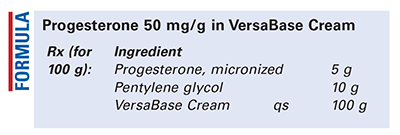US Pharm. 2017;42(9):47-48.

Method of Preparation: Calculate the quantity of each ingredient for the amount to be prepared. Accurately weigh or measure each ingredient. Mix the progesterone with the pentylene glycol until the mixture is uniform and smooth. Geometrically, incorporate the VersaBase Cream and mix well. Package and label. A dispensing-type container works well for these products after it has been calibrated.
Use: This preparation has been used in hormone replacement therapy.
Packaging: Package in tight containers.
Labeling: Keep out of reach of children. For external use. Use only as directed. Discard after ____ [time period].
Stability: Check with the manufacturer of the VersaBase Cream for a beyond-use date for this preparation.1
Quality Control: Quality-control assessment can include theoretical weight compared with actual weight, apparent pH, specific gravity, active drug assay, color, texture–surface, texture–spatula spread, appearance, feel, rheologic properties, and physical observations.2
Discussion: Bioidentical hormone replacement therapy (BHRT) generally includes the hormones progesterone, estradiol, estrone, estriol, and testosterone. In some instances, dehydroepiandrosterone also is used. Numerous single-drug formulas, as well as multiple-drug formulas, are prescribed and compounded. Compounded BHRT preparations include oral, topical/transdermal, parenteral, and nasal administration; implants; and others. The formulation used is determined by the physician, patient, and pharmacist—the triad relationship.
This preparation has been studied for its ability to transport progesterone into and through human skin.3 In a comparison with Vanicream, it delivered more than four times as much progesterone deep into the dermis.3 The study was designed to evaluate the percutaneous absorption pharmacokinetics of progesterone. Absorption was measured in human cadaver skin, in vitro, using the finite dose technique and Franz diffusion cells. Formulas tested included VersaBase Cream Cosmetic HRT, a mixture of VersaBase Cream with VersaBase Gel (95:5), and Vanicream. The study was conducted over 40 hours with seven sampling times. Sampling was in triplicate. Flux rates in the system were maintained from 2 to 40 hours in the range of 0.10 to 0.16 mcg/cm2/hour.1,3
Progesterone is a naturally occurring progestin that occurs as a white or creamy white, crystalline powder that is practically insoluble in water, soluble in alcohol, and sparingly soluble in vegetable oils. It melts at about 126°C to 131°C and exists as a polymorph that melts at 121°C. Progesterone is compounded into numerous dosage forms, including topical solutions, creams, gels, transdermal gels, injections, capsules, troches, minitroches, nasal sprays, and others. It is commercially available orally and as a parenteral injection in a suitable solvent. The solution should not be frozen. Progesterone is extensively metabolized by the liver and is not usually given by the oral route, with some exceptions.4,5 For preparations that will be applied topically, a micronized form of the powder should be used.
Pentylene glycol (1,5-pentanediol, C5H12O2, HOCH2CH2CH2CH2CH2OH, MW 104.149) is a synthetic humectant used in cosmetics and beauty products that is also used secondarily as a solvent and preservative. It is both water-soluble and oil-soluble, and it has moisture-binding/humectant, skin conditioning, and antimicrobial properties. Pentylene glycol occurs as a viscous, colorless liquid that is also used as a plasticizer, and it forms polyesters that are used as emulsifying agents and resin intermediates. Pentylene glycol has a density of 0.994 g/mL at 25°C, a melting point of –18°C, and a boiling point of 242°C. It is often added as an additional moisturizer to a cream or other skin-care product in order to further condition the skin and improve texture.6
VersaBase Cream (PCCA) consists of water, ethylhexyl stearate, emulsifying wax, tocopheryl acetate, aloe barbadensis leaf juice, disodium ethylenediaminetetraacetic acid, sorbitol, cyclopentasiloxane, methylchloroisothiazolinone, and methylisothiazolinone. It is an oil-free, petrolatum-free, paraben-free, propylene glycol–free, and noncomedogenic cream. VersaBase Cream may be used anywhere on the body; it is thick but rubs in rapidly, leaving a soft, silky feel. A wide variety of active ingredients may be incorporated into it. VersaBase Cream has a pH of approximately 6 and a pH stability range of 3 to 9, and its salt resiliency is good.1
REFERENCES
1. PCCA. Products. www.pccarx.com/pcca-products. Accessed August 1, 2017.
2. Allen LV Jr. Standard operating procedure for performing physical quality assessment of ointments/creams/gels. IJPC. 1998;2:308-309.
3. PCCA. PCCA VersaBase® Cream, Cosmetic HRT™, VersaBase® Gel and Special Micronized Progesterone study®. www.pccarx.com/about-pcca/pcca-news/item/208-pcca-versabase-cream-cosmetic-hrt-versabase-gel-and-special-micronized-progesterone-study. Accessed August 1, 2017.
4. Allen LV Jr, ed. Remington: The Science and Practice of Pharmacy. 22nd ed. London, England: Pharmaceutical Press; 2013:1695-1696.
5. U.S. Pharmacopeia/National Formulary [current revision]. Rockville, MD: U.S. Pharmacopeial Convention, Inc; August 2017.
6. 1,5-Pentanediol. https://en.wikipedia.org/wiki/1,5-Pentanediol. Accessed August 1, 2017.
To comment on this article, contact rdavidson@uspharmacist.com.





